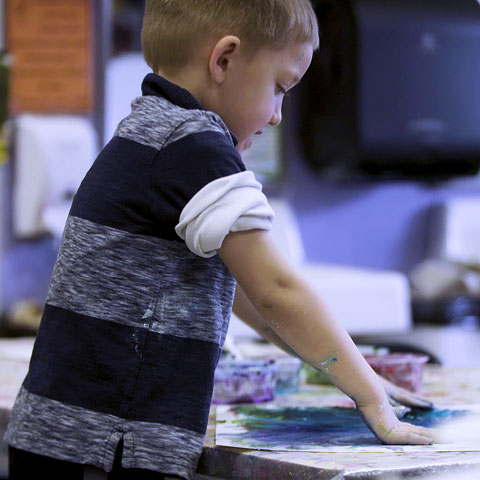About this video
Teachers help children develop their science skills by creating engaging activities that activate children’s curiosity and desire to discover the properties of materials. A visual art activity, such as the finger painting activity we see in this video, can be an opportunity to explore science concepts.
In this video, we see Leo, age 4, finger paint. His teacher facilitates Leo’s thinking by sharing her observations of his painting process and describing how he mixes colors to create a new hue. She also encourages his thinking about cause and effect as he makes lines with his fingernails and smooths them out with his palm.
Video
Transcript
Teacher: (Unintelligible), yeah. Oooh, you made some purple right there.
You’re mixing colors.
And you know what? You can use your nails and scratch.
(Laughs) Woah, isn’t that crazy?
Whoo! Look at that, ahh.
Leo: That’s two big scratch.
Teacher: Two big scratches.
Teacher 2: Those are two big scratches, that’s for sure.
Teacher: Then you can erase them and smooth them out again. I tell you …
Benchmarks and How They Were Met
| Benchmarks | How They Were Met |
|---|---|
| Language Arts 1.D.ECa: With teacher assistance, use complete sentences in speaking with peers and adults in individual and group situations. 1.D.ECb: Speak using age-appropriate conventions of Standard English grammar and usage. 1.E.ECb: Exhibit curiosity and interest in learning new words heard in conversations and books. 1.E.ECc: With teacher assistance, use new words acquired through conversations and book‐sharing experiences. | The teachers repeat the child’s words to expand on his language. For example, the child says “that’s two big scratch.” A teacher affirms his use of the vocabulary but then helps him correct the sentence structure by saying “Those are two big scratches, that’s for sure.” The teacher helps the child use complete sentences with appropriate conventions through this interaction. |
| Science 11.A.ECf: Make meaning from experience and information by describing, talking, and thinking about what happened during an investigation. | The child participates in a science investigation while mixing paint and using his hands to actively explore the materials. The teacher mentions that he is “mixing colors” and that he “made purple.” She also encourages the child to scratch his paper to make lines. The child reflects on what he is doing and describes his actions by saying “that’s two big scratch.” |
| The Arts 25.A.ECd: Visual Arts: Investigate and participate in activities using visual arts materials. | The child shows his appreciation of the visual arts by actively exploring the paint with his fingers. He makes designs with his nails and then learns to smooth the scratches out with his palms. |
| Social/Emotional Development 30.C.ECa: Exhibit eagerness and curiosity as a learner. 30.C.ECc: Show some initiative, self-direction, and independence in actions. | The child shows eagerness and curiosity about his activity. The teacher also helps the child develop more excitement by saying “whoo” and “woah” to show her own excitement. She also helps the child by offering ideas about what he can do with the paint and his fingers. By offering suggestions, the teacher helps the child develop self-initiative. |


